| Srl | Item |
| 1 |
ID:
032847


|
|
|
|
|
| Publication |
London, Mcgrgw - Hill Publishing, 1969.
|
| Description |
399p
|
|
|
|
|
|
|
|
|
|
|
|
Copies: C:1/I:0,R:0,Q:0
Circulation
| Accession# | Call# | Current Location | Status | Policy | Location |
| 004128 | 330.015195/NIC 004128 | Main | On Shelf | General | |
|
|
|
|
| 2 |
ID:
125861


|
|
|
|
|
| Publication |
2013.
|
| Summary/Abstract |
Coal-fired power plants take a significant share in electricity production at present. Therefore, emission reduction, especially sulfur dioxide (SO2) is essential. Thus, the coal-fired power plants are built with "Flue Gas Desulfurization (FGD)" units. Turkey has retrofitted exiting thermal power plants with new FGD units. Turkey's installed electricity generation capacity was 49,524 MW in 2010. The coal-fired thermal plants made up 26% of this capacity. However, only 4107 MW of lignite fired power plants are equipped with the retrofit FGD units. In this paper, the additional cost burden of the retrofitted FGD units to the national electricity generation is thoroughly evaluated using the technical and economic parameters. The share of the FGD investments is vital for the domestic energy investments and electric power sector. The FGD unit cost may increase the investment rate up to 17%. The proposed indicators are presented to introduce effectiveness for FGD investments in the energy sector. The parameters and indicators of the FGD investments in Turkey are depending on the new air pollution control legislations. The relationship between the rise of the FGD investments and the national macroeconomic indicators such as economic growth, state debt, and foreign investment rate in Turkey are shown with actual data.
|
|
|
|
|
|
|
|
|
|
|
|
|
|
|
|
| 3 |
ID:
150820
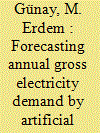

|
|
|
|
|
| Summary/Abstract |
In this work, the annual gross electricity demand of Turkey was modeled by multiple linear regression and artificial neural networks as a function population, gross domestic product per capita, inflation percentage, unemployment percentage, average summer temperature and average winter temperature. Among these, the unemployment percentage and the average winter temperature were found to be insignificant to determine the demand for the years between 1975 and 2013. Next, the future values of the statistically significant variables were predicted by time series ANN models, and these were simulated in a multilayer perceptron ANN model to forecast the future annual electricity demand. The results were validated with a very high accuracy for the years that the electricity demand was known (2007–2013), and they were also superior to the official predictions (done by Ministry of Energy and Natural Resources of Turkey). The model was then used to forecast the annual gross electricity demand for the future years, and it was found that, the demand will be doubled reaching about 460 TW h in the year 2028. Finally, it was concluded that the approach applied in this work can easily be implemented for other countries to make accurate predictions for the future.
|
|
|
|
|
|
|
|
|
|
|
|
|
|
|
|
| 4 |
ID:
027290


|
|
|
|
|
| Publication |
New York, OECD, 1969.
|
| Description |
135p.
|
|
|
|
|
|
|
|
|
|
|
|
Copies: C:1/I:0,R:0,Q:0
Circulation
| Accession# | Call# | Current Location | Status | Policy | Location |
| 004662 | 330.021/OER 004662 | Main | On Shelf | General | |
|
|
|
|
| 5 |
ID:
130534
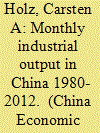

|
|
|
|
|
| Publication |
2014.
|
| Summary/Abstract |
Monthly economic indicators are used for a variety of purposes, from studying business cycles to determining economic policy and making informed business decisions. China's published monthly industrial output statistics could hardly be more confusing, with changes in variables, in coverage, in measurement, and in presentation. This paper reviews the available official data and proceeds to construct a monthly industrial output series in nominal terms and in real terms for the period 1980-2012, economy-wide and for the public sector.
|
|
|
|
|
|
|
|
|
|
|
|
|
|
|
|
| 6 |
ID:
131381


|
|
|
|
|
| Publication |
2014.
|
| Summary/Abstract |
This paper addresses new challenges and identifies starting points for development theory following recent debates in Latin America on 'new or neo-extractivism'. It focuses on the concept of neo-extractivism and the context of its emergence, and on the changing role of the state. Looking at a number of social economic indicators, we find that, even after considering differences between countries, (neo-)extractivism is not merely a temporary economic strategy in the region. Instead, it exhibits features of a consolidated development project. Empirical evidence from the region shows the fundamental implications of resource-based development paths in politics, social relations and territorial orders. To grasp these implications conceptually, we argue for a shift in theoretical perspectives related to the link between development and resource extraction. Key elements for such a shift are to be found in recent studies in rentier theory and politics and new approaches in the field of political ecology.
|
|
|
|
|
|
|
|
|
|
|
|
|
|
|
|
| 7 |
ID:
116548


|
|
|
| 8 |
ID:
041067
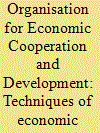

|
|
|
|
|
| Publication |
Paris, Organisation for economic cooperation and development, 1965.
|
| Description |
173p.
|
| Series |
Economic studies
|
|
|
|
|
|
|
|
|
|
|
|
Copies: C:1/I:0,R:0,Q:0
Circulation
| Accession# | Call# | Current Location | Status | Policy | Location |
| 012364 | 330.0112/OEC 012364 | Main | On Shelf | General | |
|
|
|
|
| 9 |
ID:
131669
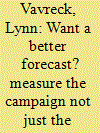

|
|
|
| 10 |
ID:
130852


|
|
|
|
|
| Publication |
2014.
|
| Summary/Abstract |
The article examines economic conditions in India and that country's middle class. Conflicting estimates of the population of India's middle class are cited as an indication of the difficulty in estimating economic indicators in developing countries due to the large informal sector of their economies. Economic and social indicators for India including its large percentage of younger adults, urbanization and consumption suggesting India's middle class will increase in size are discussed.
|
|
|
|
|
|
|
|
|
|
|
|
|
|
|
|
| 11 |
ID:
048514
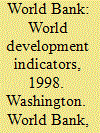

|
|
|
|
|
| Publication |
Washington, World Bank, 1998.
|
| Description |
xxv, 389p.
|
| Standard Number |
08213370141243
|
|
|
|
|
|
|
|
|
|
|
|
Copies: C:1/I:0,R:0,Q:0
Circulation
| Accession# | Call# | Current Location | Status | Policy | Location |
| 041315 | 362.05/WOR 041315 | Main | On Shelf | General | |
|
|
|
|